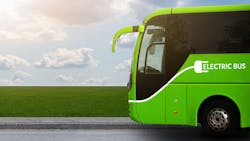Expert Insight: Safety priorities when implementing zero-emissions technology
Safety is a top priority for public transit agencies where safety decisions are being made every second of every day. Whether it’s a bus operator approaching an intersection or a public transit CEO, safety is everyone’s responsibility. That’s why, as the U.S. integrates zero-emissions technology into transit networks across the country, safety needs to be at the forefront of planning.
Let’s remember older technologies came with risks, but history proves the challenges of implementing these technologies can be overcome with ingenuity, collaboration and steadfast commitment.
Safety in zero-emissions programs
Areas of focus when developing a sound safety program include the design of vehicles, facilities and other infrastructure, establishing and enforcing operating policies and procedures, as well as training and communicating to the agency’s workforce and external stakeholders.
A safety program is most effective when leadership works closely with Original Equipment Manufacturers (OEMs), facility designers, first responders and the internal workforce. Keeping up to date on the latest technology advancements, guidance and regulations from the National Fire Protection Association (NFPA), Occupational Safety and Health Administration and other governing bodies and establishing, implementing and auditing safety protocols are also vital to success.
There are five main safety elements that require planning, training and execution when implementing a zero-emissions program.
- Vehicle operation
- High voltage systems
- First response
- Lithium-Ion traction batteries
- Hydrogen as a fuel
Vehicle operation
When new vehicles are added to a fleet, they require new training and acclimation. Zero-emission vehicles emit less noise when they accelerate, so operators need to have a keen awareness of pedestrians in the street and around yards and depots, as these individuals cannot hear an oncoming vehicle the same way they can with a standard bus vehicle.
Additionally, the acceleration profile of these vehicles can be steeper, increasing the risk of on-board accidents from those not sitting or holding firmly. This may require the operator to leave an additional buffer from vehicles in front of the bus.
High voltage
For many employees, working around high voltage is a new job requirement that comes with a host of safety considerations. High voltage electrical training programs should incorporate transportation and maintenance personnel, supervision and leadership, as well as emergency responders.
Lock-out/tag-out programs should be updated due to new risks relating to the high voltage systems, which mechanics are occasionally required to work on while these systems are energized. Shock and potential arc-flash hazards may be encountered and need to be safely managed. Specialty tools such as insulated wrenches or digital multi-meters rated for higher protective classes need to be procured; and personal protective equipment such as high voltage gloves, insulating blankets and others, need proper training and handling.
Electrical safety training can be coordinated with a local electrical utility, an equipment manufacturer, consultant or by using in-house expertise. An effective training program provides initial and refresher training, so staff is proficient and up to date with changes in equipment or requirements. Resources exist in many places such as OEM literature, NFPA, local codes, other industry groups and through agency collaboration.
First response
An effective first response to any emergency starts with a well-documented emergency response plan addressing prevention, mitigation, preparedness, response and recovery. The plan should detail emergency procedures, assign responsibility and be supported by initial and refresher training.
Another key piece is to periodically revisit the plan as both the people and information change. Emergency planning exercises are key to keeping employees up to date and knowledgeable on the plan’s execution.
In the zero-emissions space, plans need to account for on-road and in-house responses and contingencies, as the two scenarios provide different sets of challenges. Any emergency response plan addresses life safety first before safeguarding of equipment and property.
Lithium Ion (Li-Ion) traction batteries
Unscheduled thermal events of Li-Ion batteries are a fleet operators’ largest concern. Proper battery management and battery monitoring software must be leveraged to manage this risk.
The agency’s safety plan needs to incorporate the asset management of items that store energy for long periods of time, including accident vehicles or their components. Spare batteries should be located away from work areas and/or preferably outside of structures that can be compromised by unscheduled thermal events.
Crucially, battery monitoring software provides proper advance notification and safeguards in the case of an impending thermal event. It is key to assign responsibility for monitoring such alarms, as well as detailing what actions should be taken in case of an alarm. Temperature monitoring of the battery needs to be utilized when running and charging the battery.
A sufficiently sized and designated “cooling” area should be clearly identified and integrated into the training program and emergency response plans. The area serves as a repository for suspect buses and/or battery packs. The local fire department should also be made aware of this area during familiarization training and incidents. Either agency staff or the fire department could opt to pull, push, tow or drive a vehicle from inside a structure or a parking lane to this area to increase safety. Autonomous vehicle technology may be employed to move the vehicle to a designated spot when an alarm is present to avoid human intervention with a vehicle in hazard.
Hydrogen as a Fuel
Hydrogen fuel cell technology is a potentially promising path for a zero-emissions public transit bus fleet because of the duty cycle it can accommodate. Fuel cell buses are electric buses with an on-board Hydrogen fuel cell that provides the propulsion electricity as needed.
The fuel cell provides most of the power the electric motor needs to drive for traction and is subject to all the battery electric bus training requirements. In addition, safety and training need to include topics that are unique to the handling of hydrogen gas and associated risks. Agencies that have experience with fuel cell buses are one of the best resources to share their experience in practical aspects of owning fuel cell buses.
Gaseous hydrogen is significantly lighter than air and rises naturally. It is a Class 1 Group B type of hazardous material and should be treated appropriately. Equipment and fueling processes need to be planned and configured to keep all required clearances. Repair garages of hydrogen fuel-cell buses need to be equipped with hydrogen sensors that are used to trigger the audible and visible alarms upon the detection of any leak. The detection system controller turns on explosion-proof and spark-resistant ventilators to immediately ventilate the area in which leakage is detected. Additionally, any potential source of ignition from mechanical equipment, such as heaters, must be automatically shut down.
When working around a compressed gas of any type, proper personal protective equipment such as eye protection is required. Hydrogen burns as an invisible flame, making it undetectable to the human eye, so specific caution must be given to open flames and potential ignition sources.
NFPA 2 provides fundamental safeguards for the generation, installation, storage, piping, use and handling of hydrogen in its compressed gas and liquid form. Fire Code and National Electrical Code (NEC) provide instructions as well.
The path to zero emissions
Leveraging ingenuity, collaboration and steadfast commitment, risks associated with zero-emissions technology can be managed. Planning, training and safety protocols are vital to a program’s success. Remember that you are not alone on this journey. The public transit industry is one of many communities working on these changes as our country embarks on a transformation that will change its landscape for generations to come.
About the Author

Craig Cipriano
Craig Cipriano is currently the senior vice president, national director of zero emissions mobility at STV and has more than 36 years of experience planning and executing large-scale multi-dimensional programs. Formerly president of Metropolitan Transportation Authority's Bus Company, Craig led the nation’s largest bus transit agency through the pandemic and set forth its path to a zero emissions fleet by 2040. He also served as acting president of New York City Transit, leading 50,000 employees at the largest public transportation agency in North America, delivering subway, bus and paratransit services to over seven million daily customers pre-pandemic, with an operating budget of $13 billion and four-year capital program of over $35 billion.
